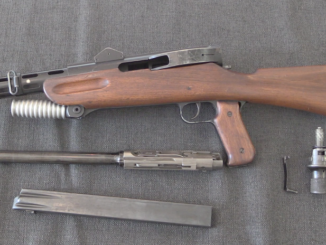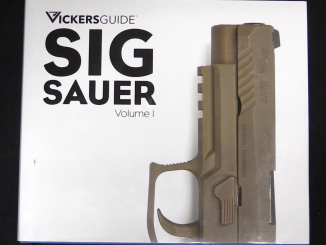This Solothurn with its carriage is being sold by Morphys on October 30, 2018.
Before they became obsolete, antitank rifles were a way to bring substantial firepower to small infantry teams – but they were never light weight. As with some of the early water cooled heavy machine guns, designers looked for ways to make the weapons more easily transported, and the solution arrived at for the Solothurn S18-1000 20mm cannon was a small wheeled mount. Complete with elevation adjustment to raise the gun just above the available cover and trail arms to secure it against recoil movement, the carriage allowed the gun to be early pulled by its crew or by a draft animal, bicycle, or light motorized vehicle. Most buyers of the guns did not opt to purchase these carriages, however, and they are quite scarce today.




Really, the best use for one of these monsters, then as now, would be as a long range anti-materiel’ weapon. And as such, mounting it on a vehicle would be the most sensible way to lug it around.
cheers
eon
I guess the plan is “shoot, scramble, and drive the victims nuts all night.”
I am pretty sure Solothurn would deliver any mount you would request from them.
Notice that theirs sub-machine gun could be used from tri-pod:
http://www.smallarmsreview.com/images/articles/art_001630/006.jpg
image from: http://www.smallarmsreview.com/display.article.cfm?idarticles=1973
They also offered S-17-100 – a sub-machine gun designed to be used exclusively from bipod/tripod, see 7th image from top:
https://www.thefirearmblog.com/blog/2016/11/21/trip-bundeswehrs-fantastic-defense-technology-museum-koblenz-part-4-submachine-guns-contd-guest-post/
notice that it did not have wooden furniture, unlike most other sub-machine guns of that era, which would prevent heat from going from metal to user hand. Also notice trigger operating in MG34-manner.
According to http://www.airwar.ru/weapon/guns/ho1.html Japanese were disappointed from theirs TYPE 97: https://en.wikipedia.org/wiki/Type_97_automatic_cannon after Nomonhan 1939 (known as Khalkhin Gol 1939 in Soviet sources), as despite it has enough penetration against then used Soviet armored vehicles, but it was heavy and thus it need 4 men to transport it around battlefield (notice that average 1930s Japanese soldier was of smaller stature than today), which drafted enemy fire.
The Type 97 Anti-tank Rifle evolved into a dual purpose (anti-armor and anti-aircraft) auto-cannon after it was given a fully automatic trigger sear and a proper mounting. Either it could be trundled around on a wheeled carriage or stuck on the bed of a truck. And yes, it could be mounted in a heavy bomber turret if need be. Any American fighter stupid enough to fly RIGHT BEHIND a Nakajima Ki-49-II-Ko without any speed or altitude advantage would get a face full of cannon shell. I could be wrong.
As Euroweasel already noted there existed full-auto capable version of S18-1000, namely S18-1100. Technically in most cases converting self-loading rifle into selective-fire one is not terribly hard, but effect might be far from desired.
This both apply to rifle caliber and 20 mm caliber. Well in fact requirements for AT self-loading rifle and AA autocannon are quite different. In first case penetration ability is of paramount importance, in second maximal Rate-of-Fire is of paramount importance, both in sense of cyclic (theoretic) and actual (real) i.e. including time needed to load fresh magazine/clip/belt.
So for AT uses rather small magazine was better, when for AA rather big.
For self-loading weapon cyclic Rate-of-Fire is irrelevant, for AA more is better.
Notice Royal Italian Army had Solothurn’s for AT work and 20 mm Breda Modello 35 (and 20 mm Scotti in smaller number) for AA work.
According to: http://212.178.67.161/avx/sites/flak2cm/start.php?main_cat=15&sub_cat=144&visitor_level=1&user_id=0&user_name=&session_id=a62f2dde2088e1b1d16e690a9fa0b504&access=view&exp_sub_cat=0
Finnish forces utilized converted some Lahti L-35 to full-auto to be used in AA role during Continuation War, when they were useless against new Soviet armored vehicles
The Italians mounted the S18-1000 and the selective fire S18-1100 on patrol vehicles in the desert. Especially the Fiat-SPA AS42 “Sahariana” had the S18-1100 as intended main armament, although in practice the Italians preferred the 20mm Breda AA gun, which was more accurate in full auto.
The action of the Breda 35 was considered more reliable too, altough the S18 1100 was more apt to field work due to the very low profile. https://i.redd.it/s5rflwdd0sb11.jpg
Link to the shooting video:
Solothurn S18-1000: The Pinnacle of Anti-Tank Rifles
https://www.forgottenweapons.com/solothurn-s18-1000-the-pinnacle-of-anti-tank-rifles/
[off-topic so ignore if you wish]
As you might know Armée de Terre adopted new weapon namely HK416F. Due to that they created movie in which they compare with M1886 rifle. You can’t believe? So look yourself:
https://www.youtube.com/watch?v=3oyGo0_GNV4
The introductory part is a bit boring for anyone who already knows the history of the Lebel rifle. It also touts the Kropatschek style tubular magazine as an innovation, which it really wasn’t in 1886 any more. But of course it was a new thing in French service… The actual shooting comparison is pretty funny, though. Not terribly informative, but entertaining.
While it strains credulity and beggars belief, some years ago the Cuban armed forces–such as they are–unveiled the smooth-bore, low-pressure 73mm 2A28 Grom cannon from the old Soviet-era armored personnel carriers mounted on the wheeled mounting that resembled nothing so much as the old SG-43 Goryunov machine gun mounting. Jumps around a bit when fired, to say the least!
“73mm 2A28 Grom cannon”
See also: https://strangernn.livejournal.com/1570158.html
another towed version of that weapon – this one was spotted in Syria
The Grom is more like a rocket launching tube with a closed breech to protect the turret crew of the BMP-1 from the backblast than a low pressure gun. The rocket projectile reaches its maximum velocity well after it has left the tube, so most of the accelerating force does not affect the launcher. The actual recoil force is probably similar to heavy recoilless guns, which have been successfully mounted on light trucks since the 1950s.
Query in English wikipedia has following data regarding 2A28’s ammunition:
https://en.wikipedia.org/wiki/2A28_Grom#Ammunition
PG-9 (HEAT) shell is 2,6 kg heavy and has muzzle velocity 400 m/s and maximal velocity 700 m/s
OG-9 (HE-FRAG) shell mass is not given directly, but linked SPG-9 query states mass as 5,35 kg and muzzle velocity 290 m/s.
In first case momentum is 1040 in second 1551,5.
For comparison WW2-era 5 cm PaK 38 with Panzergranate 39 (2,25 kg @ 823 m/s) gives momentum 1851,75.
Ammunition for 2A28 was developed from SPG-9 ammunition, which itself is today sometimes encountered in conflicts: http://modernfirearms.net/en/grenade-launchers/spg-9-2/